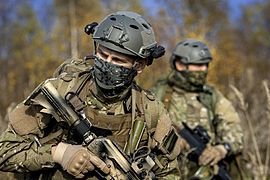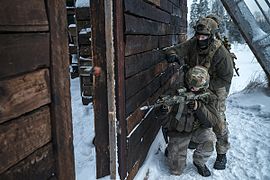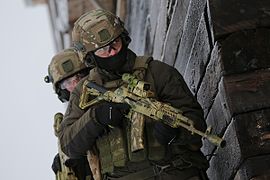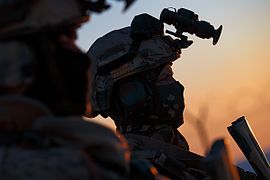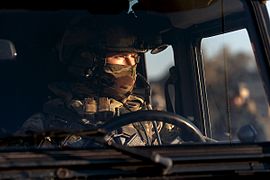Special Operations Forces (Russia)
 From Wikipedia - Reading time: 21 min
From Wikipedia - Reading time: 21 min
| Russian Armed Forces |
|---|
 |
| Staff |
| Services (vid) |
| Independent troops (rod) |
| Special operations force (sof) |
| Other troops |
| Military districts |
| History of the Russian military |
The Special Operations Forces of the Armed Forces of the Russian Federation, commonly known as the Special Operations Forces (SOF; Russian: Силы специальных операций; ССО, romanized: Sily spetsial’nykh operatsiy; SSO),[19][20] are strategic-level special forces under the Special Operations Forces Command (Russian: командование сил специальных операций; KCCO, romanized: Komandovanie sil spetsial’nykh operatsiy; KSSO or KSO)[20] of the General Staff[20] of the Armed Forces of the Russian Federation. It is also a structural and an independent unit of the Armed Forces.
The first units of what would become the Special Operations Forces were transferred from the GRU in 2009 as part of the continuing 2008 Russian military reform.[20] The Special Operations Forces Command was established in 2012 and announced in March 2013 by the Chief of the General Staff Valery Gerasimov.[21][22] According to Gerasimov, the SOF was designed as a strategic-level asset, elite special operations force units of the KSSO whose primary missions would be foreign interventions including counter-proliferation, foreign internal defense operations and undertaking the most complex special operations and clandestine missions for protecting interests of the Russian Federation.[23][24]
SOF are distinct from the Spetsnaz GRU that until 2010 were under the Main Intelligence Directorate and whose subsequent subordination was left unclear[25][21] until 2013 where the decision was reversed and GRU special forces units were reassigned to GRU divisions and placed under GRU authority again.[26] Russia's SOF are manned exclusively by professional personnel hired on contract, of which all are full-time servicemen consisting of commissioned officers and regular soldiers.[21]
On 26 February 2015, President Vladimir Putin decreed that 27 February be the Day of the SOF, according to multiple Russian official news agencies[27] (albeit not acknowledged formally), to mark the establishment of Russian control over the building of the Supreme Council of the Autonomous Republic of Crimea in Simferopol, Crimea on 28 February 2014.[28][21]
Mission and methods
[edit]
The Special Operations Forces are a highly mobile, well-trained and equipped, constant combat prepared special operations force of the Russian Ministry of Defense. Designed for performing specific tasks, the SOF have the ability to function both within the country and abroad, in peacetime and in wartime (with application of military force, by necessity).
The Russian Ministry of Defense defines the term "special operation" as "methods and ways of fighting not characteristic of conventional forces: reconnaissance and sabotage, subversion and sedition, counter-terrorism, counter-sabotage, counterintelligence, guerrilla, counter-guerrilla and other activities".[29][30]
The SOF have been primarily involved in Syria, conducting target acquisition for Russian Air Force combat planes conducting airstrikes and Russian Navy sea-launched cruise missile strikes, serving as military advisors training Syrian government troops, seek and destroying critical enemy objects, disruption behind enemy lines through ambushes, high value targeted assassinations and retaliation strikes against select groups of fighters.[31]
History
[edit]Within the Russian Federation
[edit]In 2009, as a part of the comprehensive reform of the Russian Federation's Armed Forces, Special Operations Directorate, subordinate directly to the Chief of the General Staff, was created on the basis of the GRU's 322nd Specialist Training Center in the Moscow region (Military Unit 92154).[20] The unit saw extensive action in the Caucasus region and earned the nickname podsolnukhi (sunflowers), a nickname given to the soldiers assigned to the unit while serving in Chechnya. It was reported that Colonel Oleg Martianov, who later became a member of the board of the Military-Industrial Commission, was one of the founders and first commander of the SOF from 2009 to 2013.[32]
In 2012, the Special Operations Directorate was reorganized as Special Operations Command, which was followed by plans to upscale the Forces manpower up to 9 special purpose brigades.[21]
On 6 March 2013, General Valery Gerasimov announced the creation of the Special Operations Forces. While speaking to foreign military attaches in Moscow, he said: "After reviewing the practice of the formation, training and the use of special operations forces in the leading countries of the world, Russia's Defense Ministry has also begun to create them... A corresponding command was created, which is engaged in planning work and implements a plan of training of the Armed Forces... A set of documents has already been elaborated to determine the direction of development, methods of training and application of these forces".[22][33]
On 15 March 2013, according to Russian media reports, the creation of the Special Operations Center of the Ministry of Defense for around 500 professional soldiers began in the suburban village of Kubinka-2. The Formation of the center was scheduled to be completed by the end of 2013. The center would be directly subordinate to the Special Operations Forces Command of the Russian Ministry of Defense.
At the end of April 2013, units of the Special Operations Forces conducted a special tactics exercise at Elbrus mountains at an altitude of 4,500 meters. The exercise was dedicated to practice transportation of one of the SOF units by military transport aviation and army aviation, as well as air insertion of personnel and cargo into target the area.[34][35]
During peacetime, the SOF may also be called in to execute certain specialised homeland security operations. In May 2013, the General Staff said that the unit would be tasked with security of the 2014 Winter Olympic Games in Sochi and that the SOF now comprised air and naval components.[36] Again, when Russia hosted the 2018 FIFA World Cup, the SOF and FSB special forces units took charge of ensuring the security.[37]
The SOF also conducted counter-terrorism and special operations during the insurgency in the North Caucasus region disguised as other Spetsnaz units.
On 2 December 2017, an unnamed mountain with a height of 3,939 meters located on the Sudor ridge in the Irafsky District of the Republic of North Ossetia-Alania, was named "Mountain of Special Operations Forces".[38]
Outside the Russian Federation
[edit]The SOF has also taken part in anti-piracy operations in the Gulf of Aden, clashing with Somali pirates.
In late February 2014, an unknown number of SOF operators alongside other Russian troops entered Crimea disguised as "little green men" and captured the Crimean Parliament and also began the blockading and capturing of other significant and strategic sites across the peninsula.[4][5]
SOF combat operations in Syria, which began covertly in late 2015[39] became more visible by January 2016 with the successful Latakia offensive. They played a crucial role in the Palmyra offensive, provided support to the Syrian Army attempting the recapturing of Raqqa, repelling the ISIL offensive on Palmyra and throughout the Syrian push for Aleppo in the same year.[10]
They returned during the Second battle of Palmyra in 2017 and saw action throughout the year in the Eastern Homs offensive, North Hama offensive, Operation Grand Dawn, the East Hama offensive, Operation Khuzam, rescuing a Russian Military Police unit in the Idlib de-escalation zone and the entirety of the Eastern Syria campaign. The SOF also contributed to the success of the Rif Dimashq Governorate campaign in 2018 and Operation Dawn of Idlib in 2019.
On 11 December 2017, SOF units provided top-level security for the unannounced visit of Russian President Vladimir Putin to Syria at Khmeimim Air Base by covering the most dangerous directions from sea, air and land. Vladimir Putin and Defence Minister Sergey Shoygu later personally thanked all the military personnel involved for their exemplary performance of the task.[40]
In February 2022, the SOF was involved in the full-scale invasion of Ukraine, conducting covert operations targeting critical military infrastructure and support systems of Ukraine and reconnaissance missions behind enemy lines.[41]
Structure and organization
[edit]While official numbers are classified, between the Special Purpose Center "Senezh" and the headquarters at the Special Purpose Center "Kubinka-2", analysts believe the size is around 2,000 to 2,500 total personnel. The command has supporting elements providing combat support and combat service support functions. There is a dedicated special aviation brigade that directly controls combat aviation assets at Torzhok, and a squadron of Ilyushin Il-76 transport aircraft at the Migalovo airfield near Tver.[20][1]
The Special Operations Forces Command is similar in role to the U.S. Joint Special Operations Command.[42] The command reached full operational capability later in 2013 and also serves as the central command authority for the entire SOF structure of which is subordinate directly to the General Staff.
Training
[edit]

The training of the officer recruit special operators is carried out in the Ryazan Guards Higher Airborne Command School – RVVDKU (department of special and military intelligence and the department of the use of special forces) and the Novosibirsk Higher Military Command School – NVVKU (department of special intelligence and the chair of the special reconnaissance and airborne training). At "Senezh", potential operators learn skydiving, mountaineering, swimming and military diving, and storming buildings and homes, while "Kubinka-2" focuses on maritime operations and reconnaissance and controls several naval special operations detachments.[20]
There is a cold weather/mountaineering training centre at Mount Elbrus codenamed "Terskol", in Kabardino-Balkaria and the 54th Special Reconnaissance Center in Vladikavkaz, North Ossetia–Alania. Several more sensitive centers specialised for training SOF specialists also exist in military secrecy. Depending on the individual tasks the operatives are being prepared for or specialise in, the training varies.[20]
The Special Operations Forces warfare training centers and facilities:
- Special Operations Center "Kubinka-2"
- Special Operations Center "Senezh"
- Specialist Training Center
- 561st Emergency Rescue (Training) Center of VMF
- 344th Army Aviation Training & Transition Center [ru]
- Mountain & Survival Training Center "Terskol"
- 54th Special Reconnaissance Training Center "Daryal"
Known operations
[edit]- In 2014, unidentified armed men began blockading Ukrainian bases in Crimea, and on 27 February, they seized the Crimean parliament. While claiming to be a local militia, this well-armed and highly professional unit turned out to be the first deployment of Russia's special operators.[43][44][45] On 18 March, undercover operatives captured another military base in Simferopol. According to Russian sources, SOF commander Major General Alexey Dyumin, personally conducted operations in Crimea.[46][47] Colonel Alexander Popov served as a detachment commander of the SOF and was directly involved in the events for which he was awarded the honorary title of Hero of the Russian Federation.[48]
- SOF have been tasked in recovering the flight recorder of Russia's downed Su-24M back in November 2015, on the same day rescuing the surviving crew of one of the two Mi-8AMTsh helicopters downed by Syrian Turkmen Brigade militants in a CSAR operation which had been searching for the crew of the Su-24.[citation needed]
- During the Battle of Palmyra in March 2016, Senior Lieutenant Alexander Prokhorenko was killed after he ordered an airstrike on his location after being surrounded by ISIL fighters and out of ammunition. He was posthumously awarded the honorary title of Hero of the Russian Federation for the heroic feat.[49][50][51]
- On 10 May 2017, Russian President Vladimir Putin personally awarded medals to four officers of the SOF for showing extraordinary courage combating terrorists in Syria. They were part of a 16-man special forces detachment unit which managed to successfully repulse attacks conducted by over 300 jihadists without any losses. The commander of the unit, Lieutenant Colonel Danila was awarded the honorary title of Hero of the Russian Federation.[52][53]
- On 16 August 2017, a 4-5 man SOF unit was ambushed by 40 Islamic State terrorists in the town of Akerbat and being abandoned by Syrian soldiers. After all the other members of his unit were injured, including the commander and the second officer, Lance corporal Denis Portnyagin took upon the whole job himself and killed 14 terrorists in the process and was even ready to blow his grenades to prevent their capture. He was awarded the honorary title of Hero of the Russian Federation for this feat.[54]
- On 20 September 2017, the Russian General Staff said jihadist militants tried to capture a 29-man unit of the Russian military police two days before, whom were monitoring the ceasefire in a de-escalation zone in Idlib. The trapped unit fought for several hours and were eventually rescued in a special operation by a joint task force which comprised the Syrian and Russian Air Force alongside the SOF. Three SOF operators were injured. All 29 men withdrew safely without any fatalities. Hundreds of jihadists were killed in retaliatory airstrikes by 21 September.[55][56]
- On 26 September 2017, the Russian Defense Ministry announced Russia had conducted massive cruise missile strikes in Deir ez-Zor and Idlib destroying significant ISIS and Al-Nusra Front targets.[57] On 27 September 2017, 5 Al-Nusra field commanders were killed in an airstrike alongside 32 militants in Idlib province. Another airstrike on 3 October 2017, killed 12 Al-Nusra field commanders including Ahmad al-Ghizai, Al-Nusra's security service chief and at least 50 militants in an undisclosed location in Syria. The Defense Ministry cited the use of "special measures" in those targeted strikes on militant positions, indicating the involvement of Russian special forces in the operations.[58]
- On 12 January 2018, the Russian Defense Ministry announced that the group of militants responsible for a massive mortar attack targeting the Khmeimim Air Base in Syria on 31 December 2017 which killed two Russian soldiers were liquidated in the course of a special operation. SOF operators tracked the militants to their base camp near the border of Idlib and destroyed the entire group with a Krasnopol projectile as they were boarding a minibus to leave the base. No mentions were made of which group the militants were affiliated to. Separately, a depot storing militant drones located in Idlib province was destroyed as well.[59][60]
- On 25 March 2019, the Russian Defense Ministry said that a group of more than 30 terrorists were eliminated in a special operation by the SOF and the Russian Air Force after they were identified. The operation was a retaliation for the terrorist attack in late February 2019 which killed 2 Russian servicemen. The location and affiliation of the terrorists were undisclosed.[61][62]
- During Operation Dawn of Idlib, SOF were suspected to be responsible for multiple successful raids behind enemy lines especially in Idlib province killing scores of rebel fighters including two prominent commanders from Ahrar al-Sham and Jaysh al-Nasr. Others killed were from Suqour Al-Sham, Hurras Al-Din and other various rebel factions.[63]
- On 25 August 2020, the Russian Defense Ministry said the Russian and Syrian aviation with the support of artillery and the SOF carried out a joint operation which killed 327 militants and destroyed 134 shelters, 17 observation posts, 7 ammunition warehouses and 5 underground storage facilities of ISIS from 18 to 24 August across the Syrian Desert. The operation was in response to an IED explosion which killed Major General Vyacheslav Gladkikh and wounded 3 Russian soldiers near Deir ez-Zor back on 18 August.[64][65]
- On 5 August 2024, Euromaidan Press reported that Ukrainian troops killed 5 Russian saboteurs from "Senezh" in the Chernihiv Oblast and were believed to be conducting reconnaissance for a potential Russian offensive into Semenivka. A sixth operator was believed to be unaccounted for.[66]
Casualties
[edit]According to the Russian Defence Ministry as of February 2019, there are ten cases among SOF personnel in Syria that have been confirmed to be killed in action.[67] Four members whose status are presumed to have been killed still remains unclear as of September 2019.[68][69]
Hero of the Russian Federation recipients
[edit]- Col. Alexander Popov
- Col. Vadim Baykulov
- Col. Maxim Sinyavsky
- Lt. Col. Danila Emelyanov
- Maj. Alexey Goynyak †
- LCpl. Denis Portnyagin
Commanders
[edit]
| Commander | Start of Term | End of Term |
|---|---|---|
| Col. Oleg Martyanov | 2009 | 2013 |
| Maj. Gen. Alexey Dyumin | 2014 | 2015 |
| Maj. Gen. Aleksandr Matovnikov | 2015 | 2018 |
| Maj. Gen. Valery Flyustikov | 2018 | Incumbent |
Weapons
[edit]Handguns
[edit]Submachine guns
[edit]Assault rifles
[edit]Sniper rifles
[edit]Machine guns
[edit]Explosive weapons
[edit]Equipment
[edit]Apparel
[edit]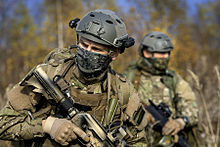
- Arcteryx LEAF (Law Enforcement and Armed Forces) kit[citation needed]
- Special Operations Forces kit for extremely hot climates[citation needed]
- Propper Multicam BDU[citation needed]
- Tactical Performance ATACS FG Tactical Field Jacket/Tactical Combat Pants[citation needed]
- Tactical Performance ATACS FG Battle Strike Uniform Coat/Trousers[citation needed]
- Tactical Performance Multicam Tactical Field Jacket/Tactical Combat Pants[citation needed]
- Tactical Performance Multicam Battle Strike Uniform Coat/Trousers[citation needed]
- Tactical Performance Multicam Tactical Combat Shirt[citation needed]
- Phantom special thermal underwear[72]
- Ratnik VKBO EMR camouflage combat uniforms[citation needed]
- Arctic raid suit "Nanuk," other special equipment for low temperatures[citation needed]
Helmets
[edit]- 6B7-1M
- Voin-Kiver RSP
- LSHZ 1+
- 6B47
- 5,45 Design Spartan 1
- 5,45 Design Spartan 2
- 5,45 Design Spartan 3
Vests
[edit]- 6Sh112 LBV
- 6Sh117 LBV
- 6B43 armor vest
- 6B45
- 6B46
- "Redut-M" armour vest
- STICH PROFI® Loading system plate carrier
- STICH PROFI® Lightweight plate carrier
- FORT Defender 2
- 5.11 Tactec Plate Carrier
- ARS ARMA Tactec Plate Carrier
- Raidgear&MBC "Phantom" universal Plate Carrier
- Raidgear&MBC MBSVest Type 2 and 3 Molle Minus universal bodyarmor
- Various Crye Precision, Survival corps, SSO/SPSON, Gear Craft, Wartech, FORT, ANA tactical, ARSARMA, Armocom plate carriers
- FORT Gladiator-A Plate Carrier
Other
[edit]- FORT OVR-3SH Combat Engineering/Demining Kit
- FORT Fortres K14 protective suit
- FORT Raid-L protective suit
- PMK gas mask
- GKN-7 diving suit
- Aqualung Amphora rebreather
- Veer-6 ballistic shield
- PT-2 thermal monocular
- Peltor Com Tac XP headset
- NRS-2 special scout knife
- ZALA UAVs[73]
- Strelets reconnaissance, control and communications system[74]
- Arbalet parachute system
Transport vehicles
[edit]Ground vehicles
[edit]Aircraft
[edit]Watercraft
[edit]- BRP SEA-DOO GTX LTD PWC
- BRP SEA-DOO RTX-215 PWC
- RBS BlackShadow DPVs (Diver Propulsion Vehicles)[citation needed]
Gallery
[edit]See also
[edit]- Special Forces of the Main Directorate of the General Staff of the Russian Armed Forces
- Foreign Intelligence Service's Zaslon
- Joint Special Operations Command (JSOC) – U.S. equivalent command
- Special Operations Forces of Ukraine - Ukrainian equivalent command
- Special Operations Forces of Belarus - Belarusian equivalent command
References
[edit]- ^ a b Galeotti, Mark. "Spetsnaz: Operational Intelligence, Political Warfare, and Battlefield Role". Marshall Center. Marshall Center Security Insight. Retrieved 15 September 2021.
- ^ "5 legendary Russian special forces units". Boris Egerov. 6 November 2019.
- ^ "Russian Special Operations Forces: Image Versus Substance". Sergey Sukhankin. 2 May 2020.
- ^ a b Михайло Глуховський (27 February 2014). "Рефат Чубаров: Людей, які захопили будівлю Верховної Ради Криму, контролює Москва". Главком. Retrieved 2 March 2017.
- ^ a b Mezzofiore, Gianluca (March 18, 2014). "Ukrainian Navy Man 'Killed' as Russian Troops Storm Simferopol Military Base". International Business Times. Yahoo! News Network. Archived from the original on March 23, 2014. Retrieved March 23, 2014.
- ^ "Russian military officer 'killed by Islamic State shelling in Syria'". YahooNews.com. 30 June 2016.
- ^ "Russia's special forces officer killed in Syria: Interfax". Reuters.com. 26 June 2017.
- ^ Leith Fadel (6 June 2016). "Another ISIS village captured as the Syrian Arab Army marches towards Raqqa". Al-Masdar News. Archived from the original on 6 June 2016. Retrieved 10 June 2016.
- ^ Yakovlev, Ivan (11 December 2016). "Syrian Army counterattacks on Palmyra outskirts in order to secure the city". Archived from the original on 18 October 2017. Retrieved 16 February 2020.
- ^ a b c "Russian Special Forces Seen as Key to Aleppo Victory". Thomas Grove. 18 Oct 2019.
- ^ "Russian special forces arrive in west Palmyra". almasdarnews. 23 August 2017. Archived from the original on 2 May 2019. Retrieved 29 October 2019.
- ^ "Russian incursions in eastern Syria hinder fight against ISIS". Diyaruna. www.diyaruna.com. 15 June 2018.
- ^ "Russian forces arrive in southern Syria". almasdarnews. 2 January 2018. Archived from the original on 30 May 2019. Retrieved 29 October 2019.
- ^ Fadel, Leith (12 February 2017). "Russian special forces arrive in west Palmyra". al-Masdar News. Archived from the original on 2 May 2019. Retrieved 29 October 2019.
- ^ "Syria war: Meeting Syria's generals in the desert". BBC. 29 Oct 2019.
- ^ "Russia: Special Forces Helping Syria Win Key City". VOANEWS.com. 26 Oct 2019.
- ^ "Regime forces advance in Syria's battered Ghouta". News24.
- ^ "Russian special forces take part in northwestern Hama offensive (photos)". Al-Masdar News. 10 May 2019. Archived from the original on 27 April 2020. Retrieved 26 August 2019.
- ^ "Силы специальных операций (ССО)". Ministry of Defense of Russia (in Russian). Archived from the original on 2017-09-06. Retrieved 22 September 2017.
- ^ a b c d e f g h Marsh, Christopher (2017). Developments in Russian Special Operations - Russia's Spetsnaz, SOF and Special Operations Forces Command (PDF). CANSOFCOM Education & Research Centre Monograph Series. Ottawa, Ontario: Canadian Special Operations Forces Command. ISBN 9780660073538. Archived (PDF) from the original on 2017-10-19. Retrieved 22 September 2017.
- ^ a b c d e День сил специальных операций в России Archived 2018-08-28 at the Wayback Machine RIA Novosti, 27 February 2018.
- ^ a b Россия решила создать силы специальных операций Archived 2018-06-27 at the Wayback Machine RIA Novosti, 6 March 2013.
- ^ Mark Galeotti. The rising influence of Russian special forces Archived 2018-08-27 at the Wayback Machine Jane's Intelligence Review, 2014.
- ^ В Вооруженных силах РФ созданы силы специальных операций Archived 2018-08-28 at the Wayback Machine RIA Novosti, 23 March 2013.
- ^ John Pike. "Spetsnaz Order of Battle". Archived from the original on 2015-09-10. Retrieved 31 July 2015.
- ^ McDermott, Roger (2 November 2010). "Bat or Mouse? The Strange Case of Reforming Spetsnaz". Jamestown. Jamestown.org. Retrieved 2014-08-19.
- ^ "February 27 declared Special Operations Force Day in Russia". Russian News Agency. 12 July 2020.
- ^ Вежливые люди получили свой День Archived 2018-06-12 at the Wayback Machine Rossiyskaya Gazeta, 27 February 2017.
- ^ "Эксклюзивные кадры действий Сил специальных операций МО РФ в Сирии". Archived from the original on 2017-03-03. Retrieved 2017-03-03.
- ^ Появилось видео работы бойцов Сил спецопераций ВС РФ в Сирии Archived 2018-08-28 at the Wayback Machine TASS, 2 March 2017.
- ^ "Press review: Sochi forum ends recession and GLONASS plays key role in Syria". Archived from the original on 2017-10-11. Retrieved 11 October 2017.
- ^ Эксперт рассказал, каким будет бронежилет спецназовца будущего Archived 2018-08-27 at the Wayback Machine RIA Novosti, 27 February 2017.
- ^ Начальник Генштаба ВС РФ Валерий Герасимов: Россия создает силы специальных операций Archived 2018-08-28 at the Wayback Machine tvzvazda.ru, 6 March 2013.
- ^ "День Сил специальных операций. Досье". TASS. 27 February 2015. Archived from the original on 2017-03-19. Retrieved 2017-03-04.
- ^ «Вежливые люди» отмечают годовщину Archived 2018-08-27 at the Wayback Machine gazeta.ru, 27 February 2017.
- ^ Cозданные в РФ силы спецопераций займутся обеспечением безопасности ОИ Archived 2018-08-28 at the Wayback Machine RIA Novosti, 18 May 2013.
- ^ "World Cup 2018: Russia promises 'unprecedented' security". BBC.com. 4 June 2020.
- ^ "Распоряжение Правительства Российской Федерации от 02.12.2017 № 2701-р". 24 July 2019.
- ^ "Russia breaks official silence to honor soldier killed in Syria". UKreuters.com. 21 Apr 2020. Archived from the original on March 17, 2016.
- ^ 27 февраля — День сил специальных операций / mil.ru
- ^ "SPECIAL FORCES, UNPRIVILEGED BELLIGERENCY, AND THE WAR IN THE SHADOWS". Lieber Westpoint. 8 March 2022. Retrieved March 11, 2022.
- ^ "Video shows Russian special troops in Syria". CNN.com. 22 May 2020.
- ^ Interest, The National. "Get Ready, America: Russia Has Its Own Deadly 'Delta Force'". Archived from the original on 2017-04-13. Retrieved 12 April 2017.
- ^ Post, Washington. "New battlefield video shows how Russia's elite KSO military unit is fighting in Syria". Archived from the original on 2017-05-06. Retrieved 8 April 2017.
- ^ Galeotti, Mark (2015). Spetsnaz: Russia's Special Forces (Elite ed.). Oxford, UK: Osprey Publishing. p. 50. ISBN 978-1-4728-0722-9. Archived from the original on 2017-04-09. Retrieved 11 April 2017.
- ^ ""Ъ": новый глава Тульской области руководил эвакуацией Януковича с Украины". Archived from the original on 2018-06-12. Retrieved 2018-08-27.
- ^ Вот Тула прилетела: Алексей Дюмин сменил Владимира Груздева на посту губернатора Archived 2018-08-28 at the Wayback Machine Kommersant, 3 February 2016.
- ^ "Попов Александр Викторович 20.11.1974 - 02.07.2018 Герой Российской Федерации". warheroes.ru. 17 July 2019.
- ^ "Russian military says special forces officer killed near Palmyra". Reuters. 24 March 2016. Archived from the original on 2018-07-11. Retrieved 2018-08-27.
- ^ День Сил специальных операций РФ. Досье Archived 2018-08-28 at the Wayback Machine TASS, 26 February 2018.
- ^ "Body of senior Russian officer killed in Syria delivered to Moscow". TASS. 29 April 2016. Archived from the original on 3 May 2016. Retrieved 30 April 2016.
- ^ "Путин лично наградил спецназовцев за подвиг в Сирии". 22 May 2020.
- ^ "16 Russian special forces against 300 fighters". CENTER FOR STRATEGIC ASSESSMENT AND FORECASTS. 23 May 2018.
- ^ "Путин вручил в Кремле госнаграды военнослужащим, отличившимся в ходе операции в Сирии". TASS.ru. 12 January 2018.
- ^ RUSSIA CLAIMS TO KILL HUNDREDS OF MILITANTS IN ONE DAY AS U.S. BATTLE AGAINST ISIS NEARS END
- ^ "Russia Claims to Kill Hundreds of Militants in One Day as U.S. Battle Against ISIS Nears End". TOM O'CONNOR. 2 Sep 2019.
- ^ "Tu-95MS bombers fired cruise missiles at terrorists' objects in Syria". syria.mil.ru. 19 June 2020. Archived from the original on 26 December 2022. Retrieved 18 June 2020.
- ^ "Russian Airstrike in Syria Wounds Jabhat al-Nusra Commander, Kills 65 Terrorists". defenseworld.net. 25 Apr 2020. Archived from the original on 19 September 2020. Retrieved 26 April 2020.
- ^ "Russia 'eliminated' rebels behind airbase attack in Syria". 25 Oct 2019.
- ^ "Russian military eliminates militants who shelled Hmeymim airbase December 31". 25 Oct 2019.
- ^ "Syria Daily: Russia Acknowledges Deaths of 3 Troops". March 26, 2019.
- ^ "ПОДРАЗДЕЛЕНИЕ ССО РОССИИ ПРОВОДИТ АНТИТЕРРОРИСТИЧЕСКУЮ ОПЕРАЦИЮ В СИРИИ". eurasian-defence.ru/. 14 July 2020.
- ^ "Jihadists suffer heavy losses in 2 ambushes carried out by suspected Russian troops". almasdarnews.com. 26 August 2019. Archived from the original on 6 August 2019. Retrieved 26 August 2019.
- ^ "Минобороны РФ отчиталось об уничтожении более 300 боевиков в Сирии". kommersant.ru. 10 September 2020.
- ^ "Syrian, Russian forces killed over 300 ISIS terrorists in central Syria". Almasdarnews.com. 5 September 2020. Archived from the original on 28 August 2020. Retrieved 16 September 2020.
- ^ Ukraine, Reporting from (2024-08-05). "Frontline report: Ukrainian fighters decimate elite Russian Special Forces unit". Euromaidan Press. Retrieved 2025-03-02.
- ^ "Канал специального назначения". telegram.me. 11 Dec 2019.
- ^ "Russian citizen reportedly killed in Syria, MoD tight-lipped". naviny.belsat.eu. 7 Feb 2020.
- ^ Названы имена троих погибших в Сирии российских военных
The Ministry of Defense has denied data on the death of three commandos in Syria - ^ Twitter https://twitter.com/ralee85/status/1075144117221556224. Retrieved 2022-10-16.
{{cite web}}: Missing or empty|title=(help) - ^ "Janes | Latest defence and security news".
- ^ "Спецназу купили "вторую кожу"". 3 February 2017. Archived from the original on 2017-02-05. Retrieved 2017-02-05.
- ^ Телеканал ЗВЕЗДА (1 March 2017). "Бойцы Сил специальных операций действуют в Сирии: эксклюзивные кадры". Archived from the original on 2017-04-05. Retrieved 11 October 2017 – via YouTube.
- ^ "Морпехи будут наводить "Ониксы" и "Калибры" с помощью "Стрельца" | Еженедельник "Военно-промышленный курьер"". Archived from the original on 2017-04-19. Retrieved 2017-04-18.
 KSF
KSF

